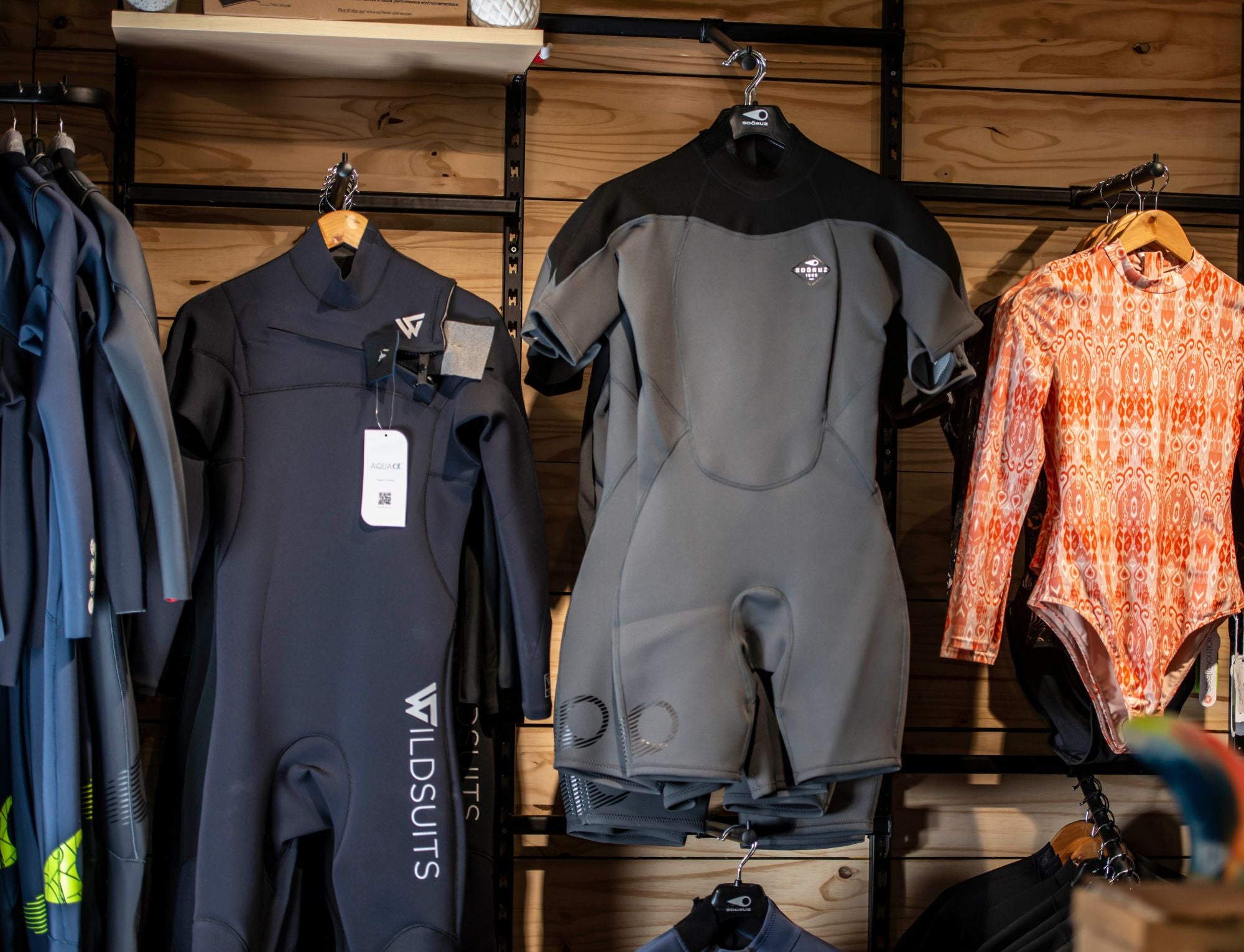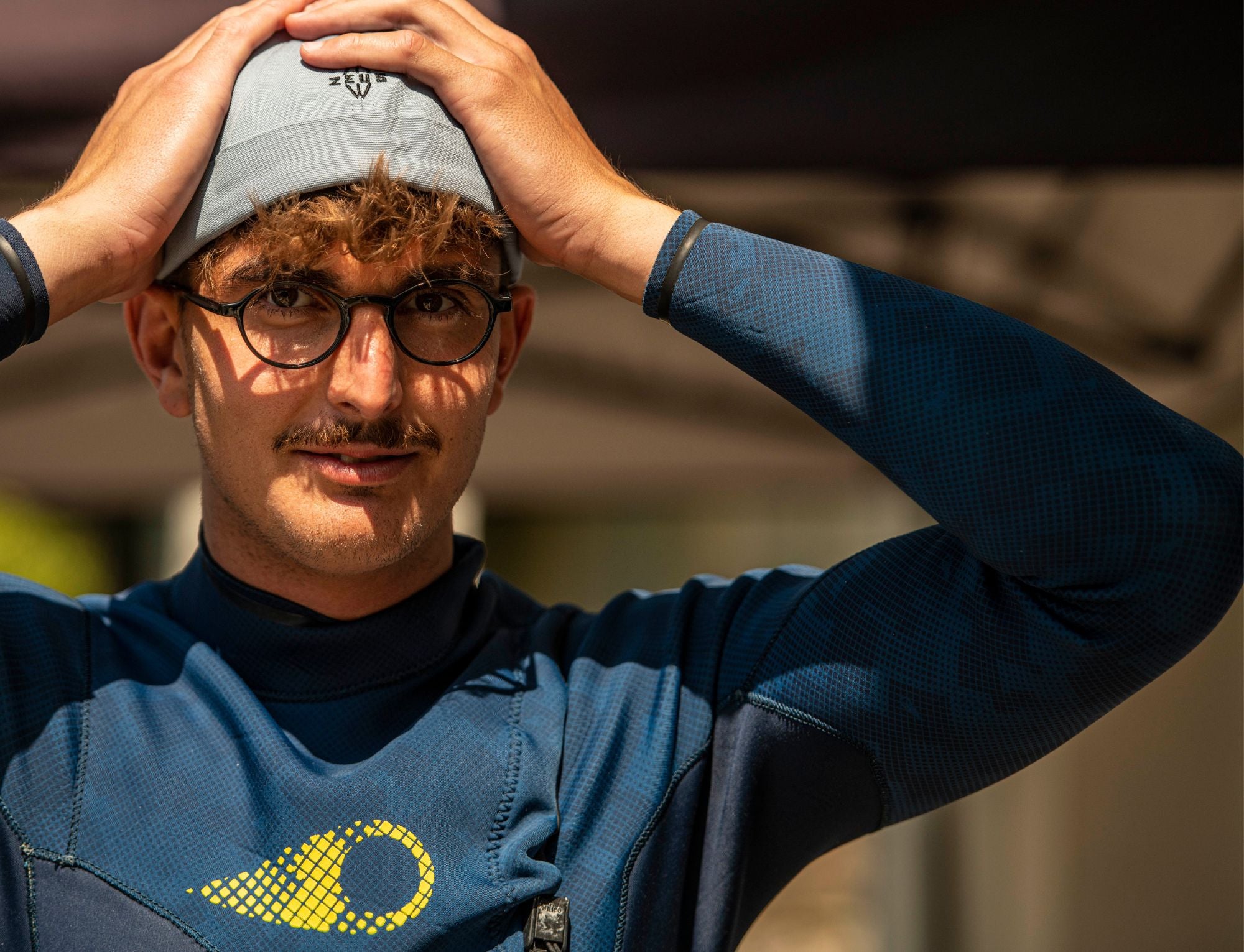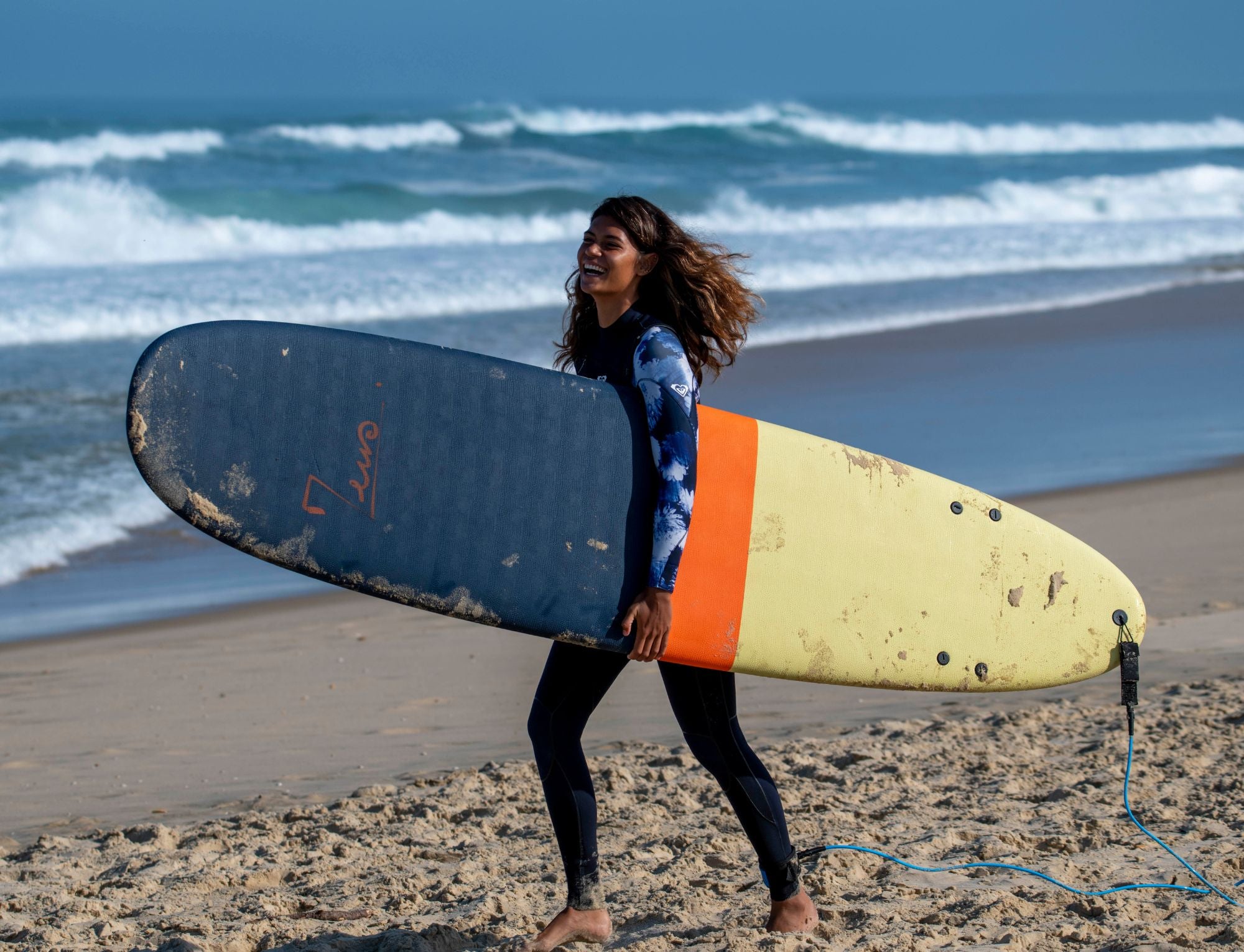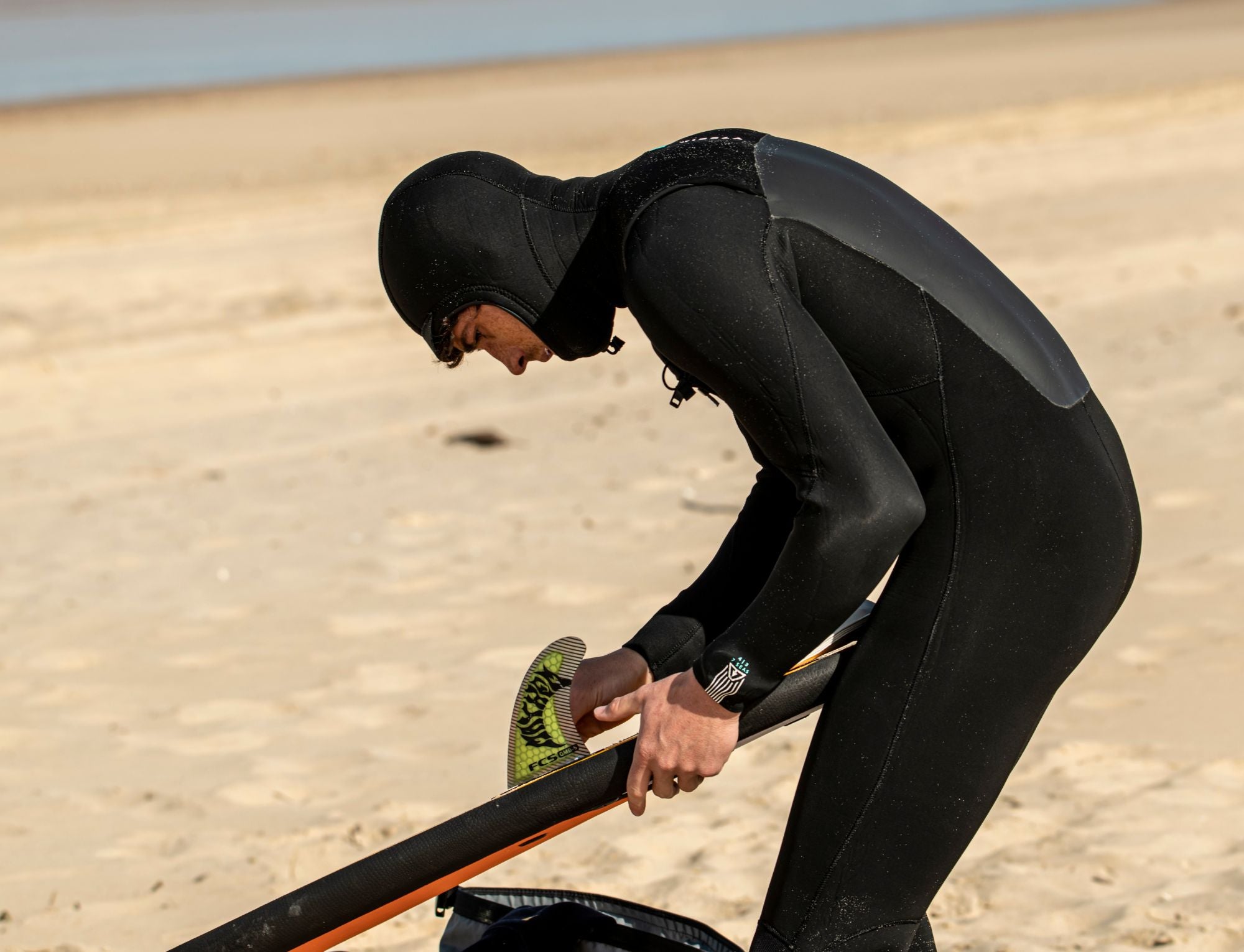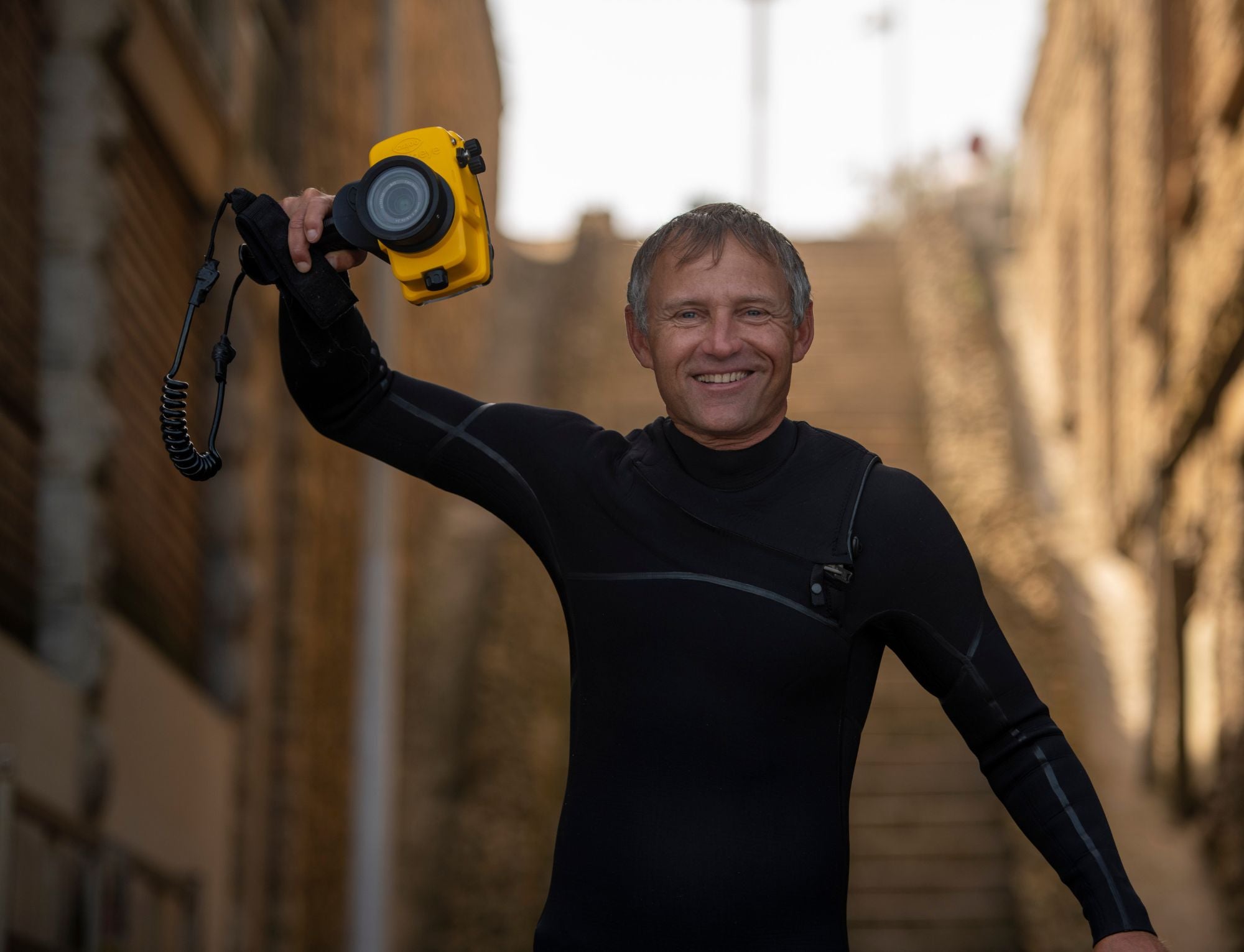Your wetsuit: the essential ally for surfing all year round
Here you are at the peak waiting for the next series. Your wetsuit sticks to your skin, you get ready to paddle. But, before you set off, a crucial question crosses your mind: is your equipment up to the task? Is your suit flexible enough, warm enough?
Your surf suit is essential, it's your second skin! It will allow you to face the waves for hours on end, in any season.
A bad choice, and your sessions will be cut short, with discomfort, restriction of movement, or even hypothermia.
Do not panic ! Armed with the sound advice in this article, you will know everything you need to know about choosing a suit suited to YOUR needs:
Surfing wetsuits have evolved a lot since Jack O'neill 's first version. The offer is developing and many brands have also launched into the production of high-end wetsuits . Today, you are spoiled for choice regarding the type of neoprene and features to favor.
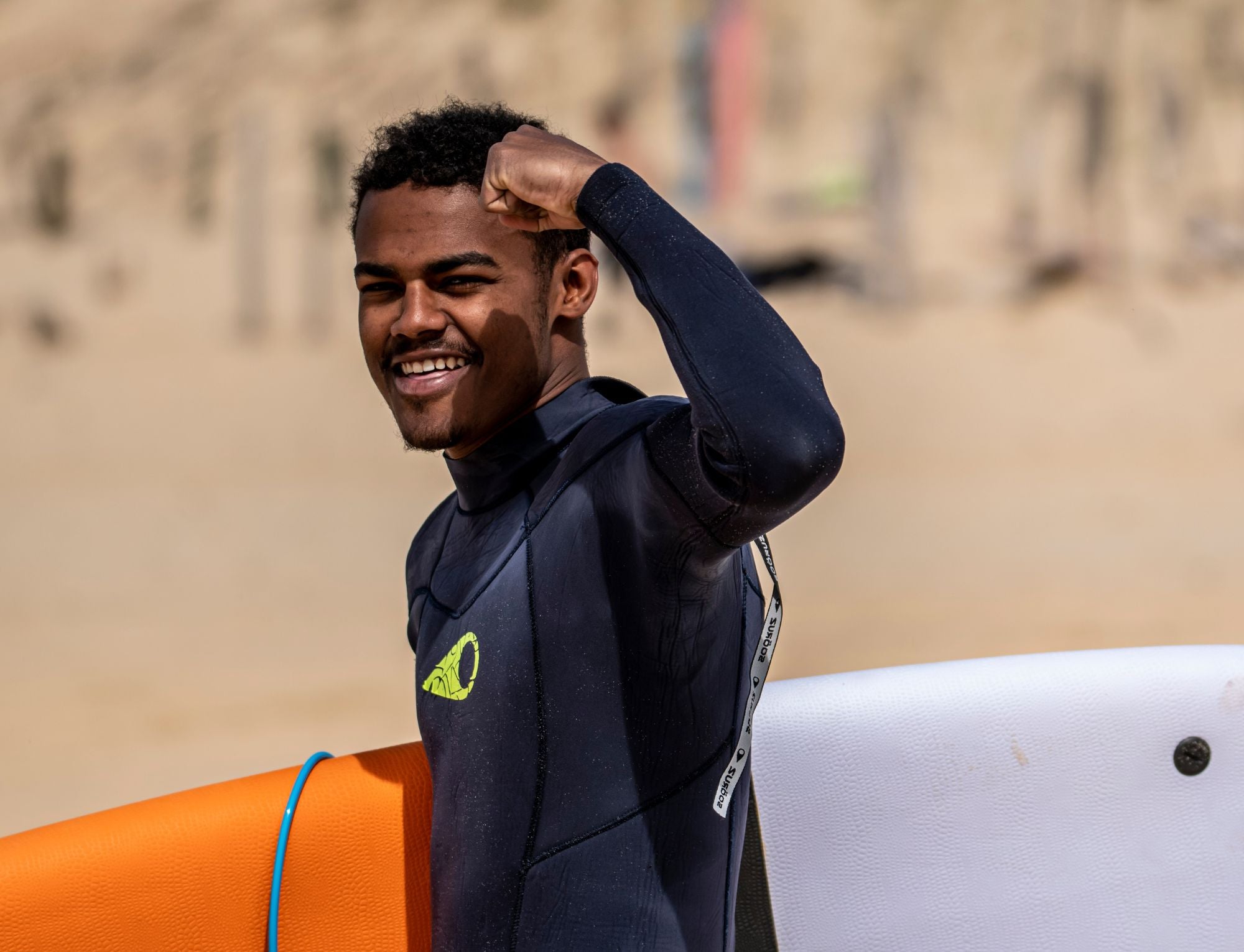
In summary
Find the key points for choosing your surf wetsuit :
- Adapt the thickness to the type of practice and the water temperature. The colder it is, the thicker the neoprene must be to insulate you.
- Check the type of stitching and closure . For optimal waterproofing, choose GBS type welded or silicone sealed seams. For greater ease, avoid back zip suits.
- Try on several sizes and models in store. The suit must fit the body without compressing or restricting your movements.
- Take your budget into account, preferably invest in a quality & durable model. Neoprene deteriorates with UV and chlorine.
- Maintain your suit well after each use: rinse, dry flat and away from the sun, disinfectant.
You can consult the complete guide for all the details and advice on choosing a tailor-made suit.
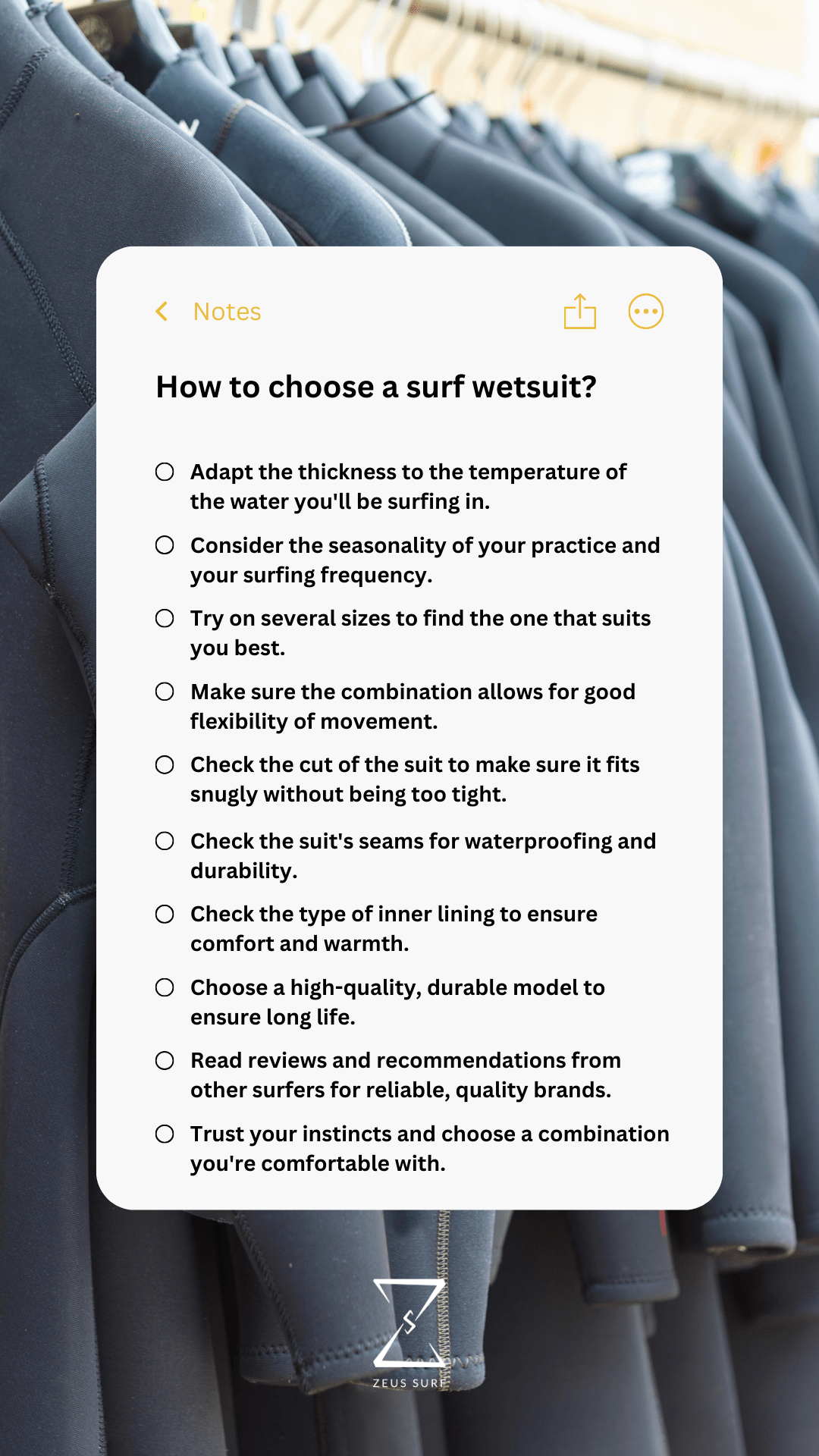
Key factors to consider
The world of surfing is often associated with technical jargon, whether for your board or for the wetsuit . So, what's better than a good 5/4/3M Chest Zip in Yulex with GBS seams and lined to face winter swells ?
Before diving headlong into the wonderful world of surf wetsuits , take the time to see things more clearly. A few key elements must be studied carefully to find the perfect fit.
Water temperature
It is THE variable that influences all the others. The colder the water, the thicker your wetsuit should be. The thicker the neoprene, the better the insulation.
But too much isn't a good idea: a suit that is too thick restricts your movements. Find the right balance with this table showing the recommended thickness depending on the water temperature:
Here is a table for wetsuit thickness recommendations based on water temperature:
| Water temperature | Suggested thickness | Combination type |
|---|---|---|
| 22°C and + | 0.5 to 2mm | Lycra / Neoprene top |
| 20-22°C | 2mm | Shorty / Spring suit |
| 18-20°C | 3/2mm | Long sleeve jumpsuit |
| 15-18°C | 4/3mm | Full suit |
| 12-15°C | 4/3mm | Full suit |
| 10-12°C | 4/3 or 5/4 mm | Full suit + hood |
| Less than 10°C | 5/4mm or more | Full suit + hood |
These recommendations are general and may vary depending on individual cold tolerance. It is important to choose the right wetsuit thickness to stay comfortable and protected in the water.
Also keep in mind that certain parts of your body are more sensitive to cold . Prioritize better insulation in the torso, back and legs.
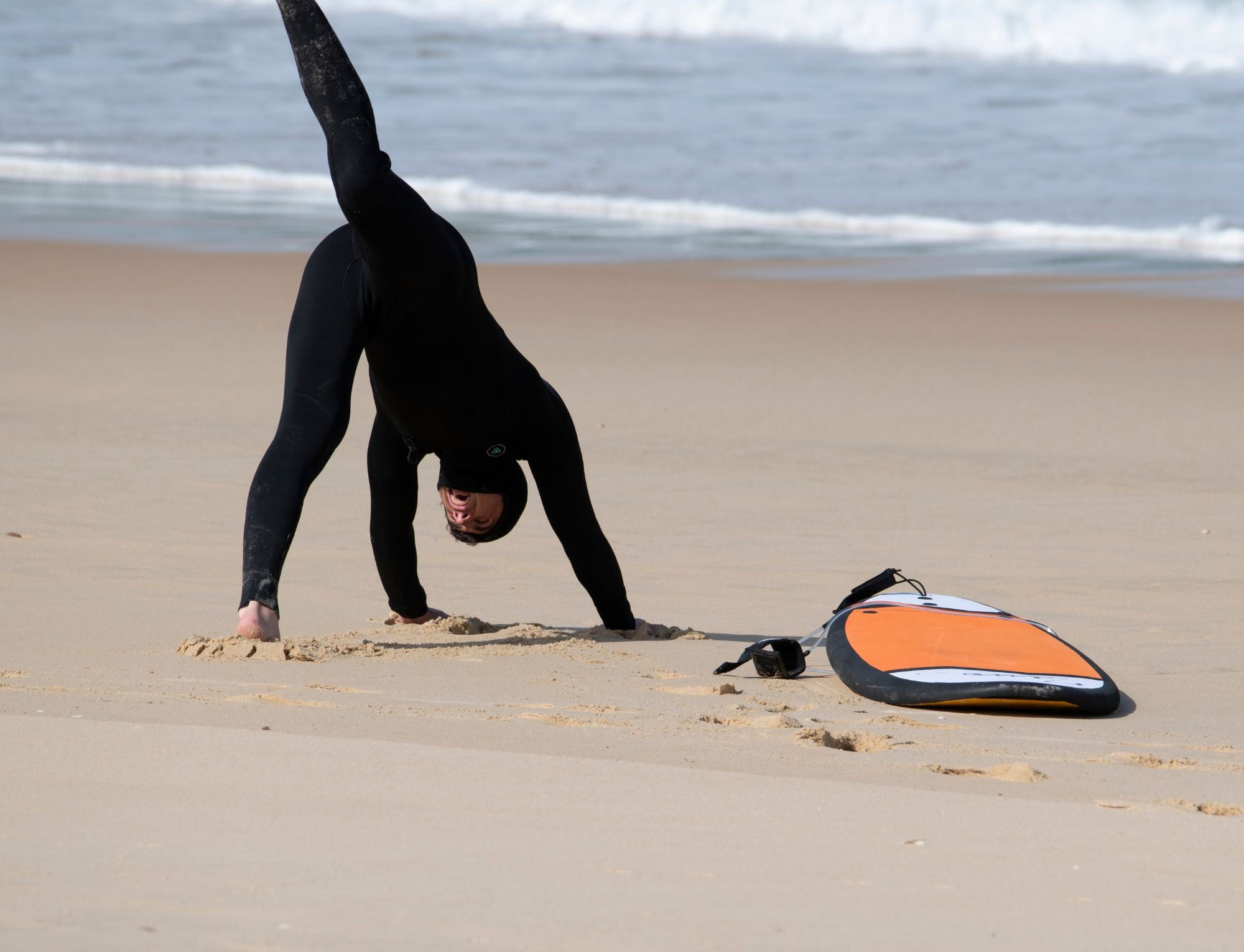
Surfing season and frequency
Your surfing style also matters when choosing your neoprene. Occasional surfer in summer, or enthusiast practicing several times a week in winter: your needs differ.
For summer use , opt for a shorty jumpsuit , light and not very covering. To surf mid-season, i.e. from Easter to All Saints' Day, a good 3/2 will be enough. Those who are more cautious can take a 4/3. If you are counting on the whole year including winter, a good 5/4 is essential.
Please note that if you surf in Brittany, in the north of France, in the Basque Country or in the Mediterranean, your needs will be different. Like boards, the regular rider has several combinations depending on the season.
The Morphology of your suit.
A jumpsuit should fit you like a glove , hugging your shape to perfection. Otherwise beware of irritating friction and restriction of movement.
To avoid this, pay close attention to the measurements when purchasing: waist size, chest size, thigh size, etc. Note them precisely and compare them to the sizes available for each model.
Pay particular attention to the neck area, and ensure the fit of the forearms and handles . If your suit is too tight, you may not be comfortable at the peak and your next session may be an ordeal.
Note: Over time, suits tend to soften
Don't hesitate to test the suit in store either, the sensation is everything!
What is the budget for a surf wetsuit?
The budget to plan for purchasing a surf wetsuit depends on different factors. Prices on the market vary greatly, ranging from around 100 euros for an entry-level model up to 600 euros for a very technical suit designed for extremely cold waters.
Generally speaking, count on an investment of 200 to 300 euros to purchase an excellent quality surf suit.
Models with a front zip closure are more expensive than those with a back zip.
The main thing is to find the combination that suits your needs and your budget. It is better to choose a reliable and durable model , even if its price is slightly higher, rather than a low-end suit with a reduced cost but premature wear. This thoughtful investment will be profitable in the long term, both from a financial and ecological point of view.
It is possible to get good deals during promotional periods or by turning to end of series and destocked models. Second-hand also represents an interesting alternative to reduce the bill, provided that the suit is thoroughly cleaned before first use.
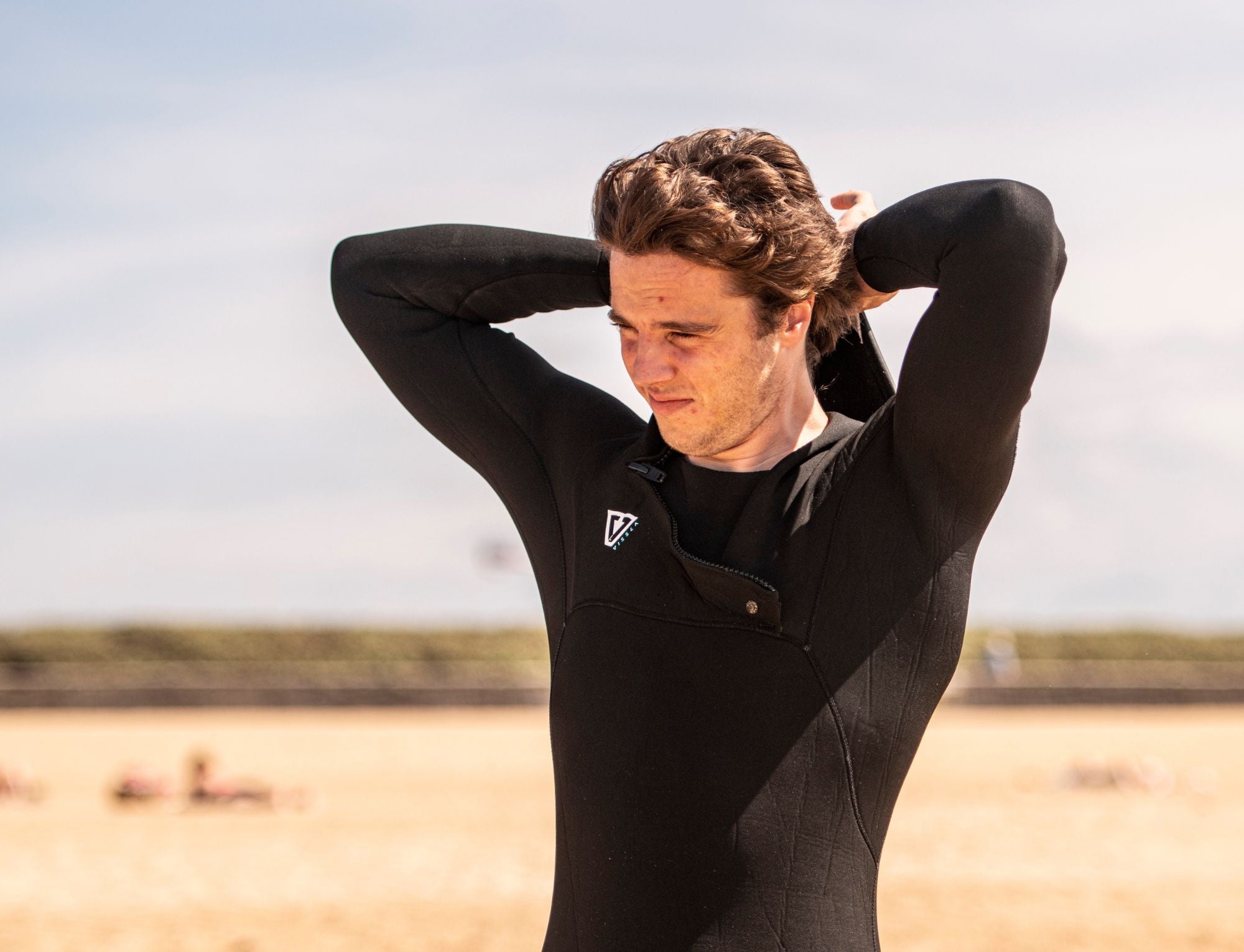
Types of neoprene
Neoprene is the main material used in the manufacture of surf wetsuits. There are several types of neoprene, each providing specific characteristics:
- Classic neoprene : this is the most commonly used type of neoprene, favoring good value for money.
- Limestone neoprene : Made from limestone, this neoprene is considered more environmentally friendly than traditional neoprene. It is also more flexible, thus offering better freedom of movement.
- Graphene neoprene : this material has exceptional thermal properties. It heats up quickly and retains heat longer than other types of neoprene.
- Recycled neoprene : Made from used tires or recycled plastic bottles, this neoprene offers a sustainable alternative and helps reduce waste.
- Yulex Neoprene: Used as an alternative to traditional neoprene, Yulex neoprene is made from natural rubber from the rubber tree . It offers comparable performance while reducing the environmental footprint of surf wetsuit production.
There are also other variants of neopene such as Oyesterprene made from oyster powder.
Interior linings
What is a liner?
The lining of a wetsuit is a thin layer of fabric glued to either side of the neoprene. It strengthens the neoprene and gives it its properties of elasticity and comfort.
Lining materials:
Here are the types of materials most commonly found on wetsuits.
- Polyester : Cheaper and more UV resistant than nylon, but less stretchy and soft.
- Nylon : More stretchy and soft than polyester, but more expensive and less UV resistant.
- Elastane : Added to polyester or nylon to improve elasticity.
- Dope-dyed yarns : Solution-dyed for greater resistance to fading and reduced environmental impact.
Types of linings:
- Simple coating:
- Smooth, waterproof exterior surface (mesh, glideskin, smoothskin).
- Interior in nylon or polyester, sometimes in quick-drying plush.
- Used for protection against wind and water.
- Double coating:
- Stretch fabric on the exterior for resistance.
- Plush interior lining for warmth and comfort.
- Used for areas that require flexibility and strength.
Plush inner lining:
- Provides extra insulation and dries quickly.
- Used on the body and upper legs.
- Slightly reduces the elasticity of neoprene.
360° stretch lining:
- Nylon and spandex for stretch in all directions.
- Comfort, flexibility and ease of donning.
Polyester lining vs. nylon:
- Polyester: Cheaper and more UV resistant, but less stretchy and soft.
- Nylon: More stretchy and soft than polyester, but more expensive and less UV resistant.
In summary :
The choice of liner depends on your needs and preferences.
If you are looking for a warm and comfortable suit, opt for a plush type lining. If you are looking for a flexible and durable wetsuit, opt for a nylon lining.
The different types of sewing
Surfing wetsuits are made of neoprene panels assembled by different types of stitching.
These seams play a crucial role in the waterproofness, strength, flexibility and comfort of the suit.
Flatlock stitching
Flatlock seams are recognizable by their exterior and interior stitches. They offer:
- Great strength: the interior and exterior stitches create a very strong seam.
- High flexibility : the flexibility of neoprene is not hampered.
- A certain comfort : the flat seams on the inside do not rub.
Their disadvantage is that they allow water to pass through. We therefore find them on wetsuits for hot water, where waterproofing is less crucial.
GBS stitching
GBS (Glued and Blindstitched) seams combine gluing , welding and exterior stitching :
- Reinforced waterproofing : the glued joint prevents water penetration.
- Increased strength: the internal neoprene reinforcement provides additional resistance.
- Versatile use : balance between waterproofness, durability and flexibility.
These seams are suitable for a wide range of conditions and practices.
Closures and zips
Surfing wetsuits generally have a back closure or a front closure . Some high-performance models are also zipless. Let's take a closer look at the advantages of each.
The dorsal or back zip
The back closure (or “backzip”) remains the most common on surf wetsuits. Its advantages :
- Easy to put on and take off
- Unfailing robustness thanks to YKK Aquaseal zips made of high-strength plastic, twice as light as metal closures
- Correct sealing
The back closure guarantees an excellent compromise between maneuverability, protection against the elements and freedom of movement.
Front chest zip
The front closure provides:
- Reinforced sealing
- Optimized protection of the torso and bust thanks to the front seal
- Less hindrance to movement
Jumpsuits without closure: zip free
Some high-performance wetsuit models (often full-length ones used in competition) do not have a closure. Their advantages:
- Maximum sealing
- Absolute freedom of movement, no discomfort
- More difficult to put on, reserved for experts
The choice of zip therefore depends on your requirements in terms of performance, thermal protection and ease of use.
You can seek advice from an expert in store to help you choose the combination that suits you best.
Different types of combinations
Surfing wetsuits are designed to be simultaneously adapted to different body types and genders.
Full suits
Full wetsuits offer optimal protection for surfing in cold waters. They cover the entire body with long sleeves and long legs.
There are models with different thicknesses of neoprene, generally between 3/2 mm and 6/5 mm. The thicker the neoprene, the more effective the thermal insulation will be.
Full-body suits have an excellent protection/movement comfort ratio. Their advantages:
- Maximum body insulation
- Freedom of movement preserved
- High durability
Shorties and short-sleeved jumpsuits
For surfing in more temperate waters, shorties and short-sleeved wetsuits provide more comfort.
These lighter models leave the arms and/or legs free to move. They are perfect for summer surfing.
We distinguish :
- Shorties : covered bust, exposed thighs
- Springsuits : covered bust and thighs, sleeveless
- Neoprene tops : top with or without sleeves
Specific combinations
Other disciplines such as windsurfing , kitesurfing , longe-coasting or stand-up paddleboarding require suitable equipment. The suits are then equipped with features that meet the unique requirements of each practice.
Long-rib combinations
- There are models with back and front closure for greater ease of putting on.
Windsurfing and kitesurfing wetsuits
- They often have small perforations at the ankles to promote water evacuation, as well as greater freedom of movement.
- "Overknee" suits stop above the knees, allowing full mobility of the legs.
- Some brands offer wetsuits with wind protection thanks to smooth neoprene on the outside.
Stand up paddle wetsuits
For the summer season, sleeveless "long john" models offer protection and comfort while revealing the arms.
So-called dry waterproof suits are perfect for winter SUP practice, completely insulating the body from the cold.
Tips for getting the most out of your wetsuit
Here are some tips to make the most of your surf suit:
- Rinse your suit after each use. This will remove salt and sand that can damage it.
- Air dry your suit. Do not use a dryer, as this may damage the neoprene.
- Store your wetsuit in a dry, cool place. Avoid leaving it exposed to the sun for long periods.
- Repair small tears as soon as possible. This will prevent them from getting worse.
How to dry your wetsuit after surfing?
To properly dry your wetsuit and extend its life , it is essential to follow a few important steps .
After each use, rinse your suit thoroughly with fresh water to remove salt and sand.
Then hang it to air dry in a shaded, well-ventilated area. Avoid hanging your suit on a traditional hanger as this risks deforming it at shoulder level.
Use specially designed accessories, such as Godry Hanger where the C-Monsta , to hang your suit for optimal drying.
The C Monsta is a sturdy handlebar with wide, curved shoulders, designed to support the weight of the suit without distorting it.
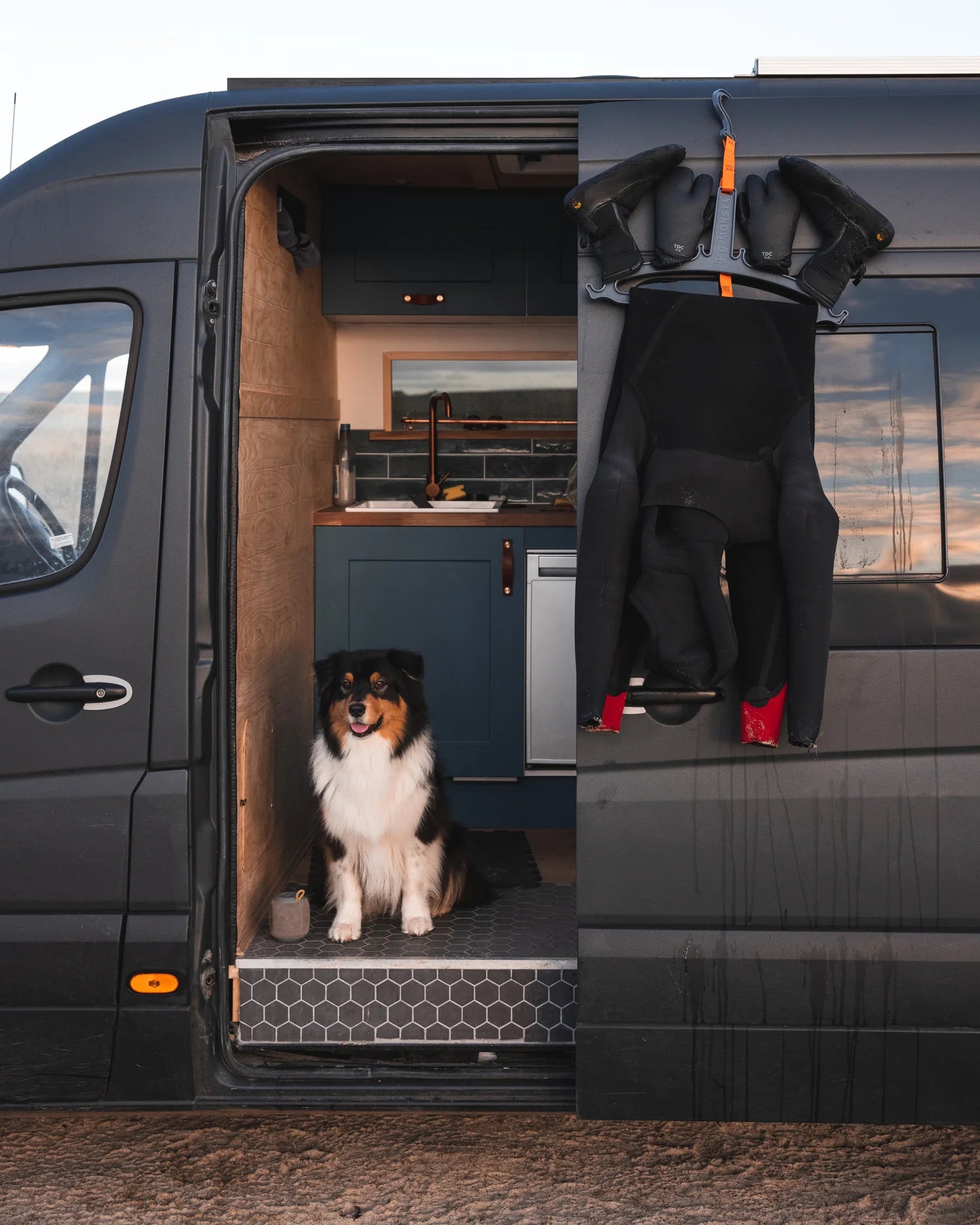 The GoDry Hanger , for its part, is a portable tool equipped with powerful suction cups, which allows you to dry your suit in optimal conditions whatever the location.
The GoDry Hanger , for its part, is a portable tool equipped with powerful suction cups, which allows you to dry your suit in optimal conditions whatever the location.

These specialist accessories help preserve the shape and quality of the neoprene while ensuring efficient drying of your wetsuit.
Also be careful not to expose your wetsuit to direct sunlight , as this may damage the neoprene.
By following these tips, you will ensure efficient drying of your wetsuit while preserving its quality and durability.
Conclusion: The importance of a good surf wetsuit
Choosing the perfect surf wetsuit is essential to guarantee comfort, performance and safety during your sessions on the water. Before making your final decision, take the time to think about your personal preferences , your level of experience , and the surfing conditions you face.
Here are the key points to remember when choosing your surf wetsuit:
- Adapt the thickness to the type of practice and the water temperature.
- Check the type of stitching and zips to ensure tightness and flexibility.
- Try several sizes and models in store to find the suit that fits your body perfectly.
- Prioritize quality and durability .
- Remember to properly maintain your wetsuit to extend its lifespan and ensure comfortable sessions every time.
Remember, every surfer is unique , and finding the wetsuit that suits you best may require a little research and patience. But by taking your time, you can be sure to make the right choice that will allow you to fully enjoy each session on your surfboard. So, may this quest for the perfect combination be an exciting and rewarding adventure. Happy surfing!
Useful Resources
To learn more about surf wetsuits, you can check out the following resources:
- Surfing wetsuits: decryption and manufacturing
- Maintaining your neoprene suit: complete guide
- All our guides and tips for surfing
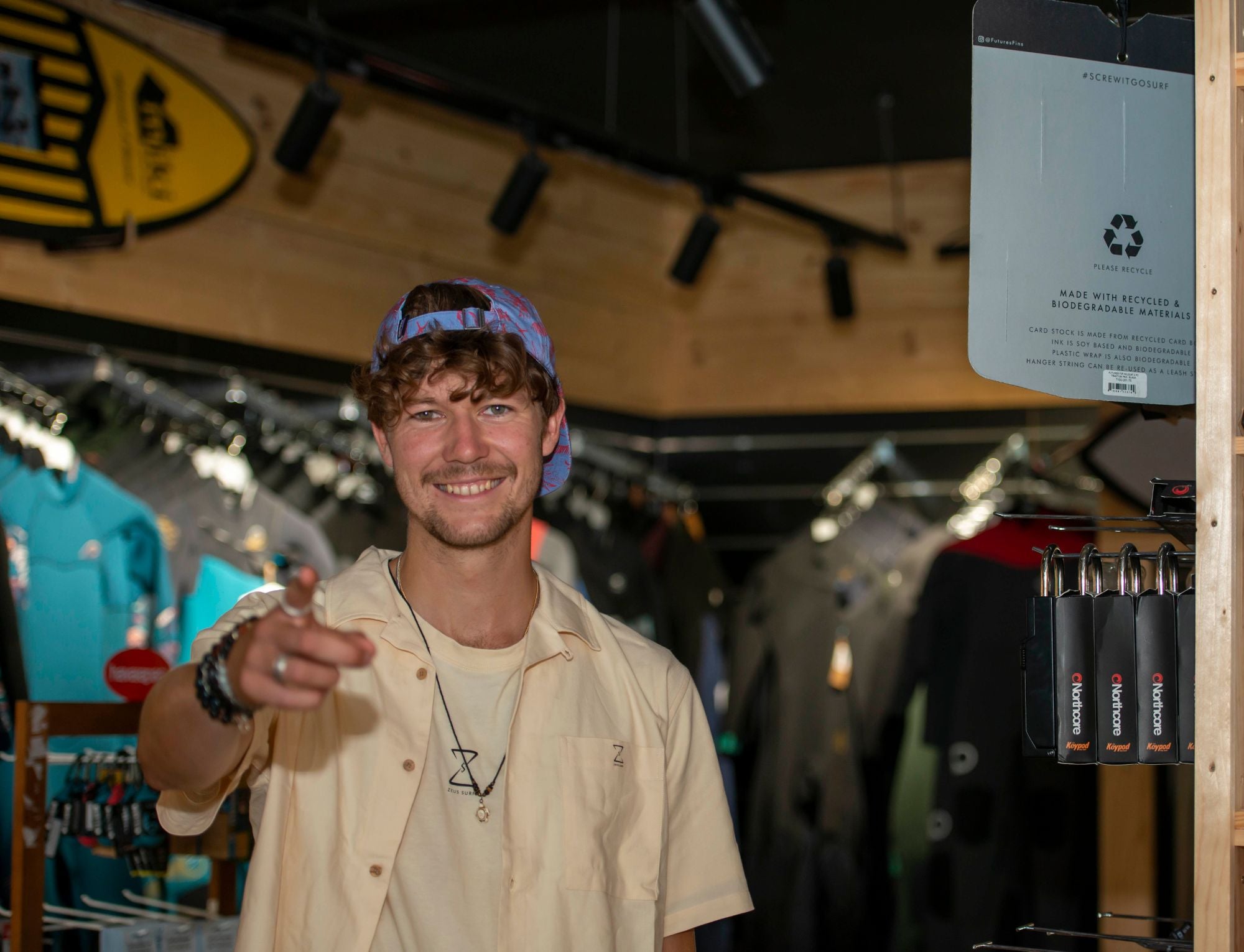
VI. Appendices
Glossary of technical terms
- Front zip : Zipper positioned at the front of the suit, at chest level.
- Backzip : Classic back zipper, in the back of the suit.
- Chest zip : Side zipper at chest level.
- Zip Free: Jumpsuit without zipper, put on through a wide opening.
- Full : Jumpsuit covering the entire body, with long sleeves and legs
- Shorty : Short jumpsuit, stopping above the knees and covering the torso and abdomen.
- Overknee : Mid-length jumpsuit, reaching above the knees. Specific model particularly used in kitesurfing.
- Long John : Long sleeveless jumpsuit, covering the torso and legs. Also called "spring suit" in English.
Men's Size Chart
| Size | Height (cm) | Weight (kg) | Chest (cm) | Size (cm) | Arm Length (cm) | Leg Length (cm) |
|---|---|---|---|---|---|---|
| 3XL | 188-193 | 104-113 | 117-122 | 96-106 | 61 | 80 |
| 2XL | 188-193 | 95-104 | 112-117 | 91-96 | 61 | 80 |
| XLT | 193-198 | 91-100 | 107-112 | 86-91 | 58.5 | 82.5 |
| XL | 185-191 | 86-95 | 107-112 | 86-91 | 58.5 | 77 |
| XLS | 180-185 | 86-95 | 107-112 | 86-91 | 57 | 73.5 |
| L.T. | 185-191 | 82-91 | 102-107 | 81-86 | 58.5 | 77 |
| L | 180-185 | 77-86 | 102-107 | 81-86 | 57 | 73.5 |
| L.S. | 175-180 | 77-86 | 102-107 | 81-86 | 56 | 71 |
| TM | 180-185 | 72-82 | 97-102 | 76-81 | 57 | 73.5 |
| M | 175-180 | 68-77 | 97-102 | 76-81 | 56 | 71 |
| M.S. | 170-175 | 68-77 | 97-102 | 76-81 | 54 | 68 |
| S | 170-175 | 61-70 | 91-97 | 74-79 | 54 | 68 |
| XS | 168-173 | 54-61 | 86-91 | 71-76 | 53.5 | 65 |
Size Chart for Women
| Size | Height (cm) | Chest (cm) | Size (cm) | Arm (cm) | Thigh (cm) | Arm Length (cm) | Leg Length (cm) | Body Length (cm) |
|---|---|---|---|---|---|---|---|---|
| 2 | 145 | 71 | 58 | 85 | 45 | 46 | 63 | 53.6 |
| 4 | 155 | 78 | 61 | 86.5 | 48 | 48.4 | 66 | 54.8 |
| 6 | 160 | 82 | 63.5 | 89 | 51 | 49.6 | 68.5 | 56 |
| 8 | 165 | 86 | 66 | 91.5 | 53.5 | 50.8 | 71 | 57.2 |
| 8T | 170 | 86 | 66 | 92 | 54 | 52 | 73.5 | 58 |
| 10 | 170 | 90 | 68.5 | 94 | 56 | 52 | 73.5 | 56 |
| 10T | 175 | 90 | 69 | 94 | 56 | 53 | 76 | 60 |
| 12 | 175 | 94 | 71 | 96.5 | 58.5 | 53.2 | 76 | 59.6 |
| 12T | 178 | 94 | 71 | 97 | 59 | 54 | 78.5 | 61 |
| 14 | 178 | 96 | 73.5 | 99 | 61 | 54.4 | 78.5 | 60.8 |
| 16 | 181 | 100 | 75.8 | 101 | 63 | 55 | 78.5 | 62 |
The list of surf wetsuit brands:
| Brand | Website | Lighthouse Model | Indicated price | Country |
|---|---|---|---|---|
| Sooruz | Sooruz | Guru | Medium - High | France |
| Xcel | Xcel | Drylock | Pupil | UNITED STATES |
| O'Neill | O'Neill | Hyperfreak | Pupil | UNITED STATES |
| Ocean & Earth | Ocean & Earth | Medium - High | Australia | |
| Deeply | Deeply | Affordable | Portugal | |
| Rip Curl | Rip Curl | Flashbomb | Medium - High | Australia |
| Billabong | Billabong | Furnace | Medium - High | Australia |
| Patagonia | Patagonia | R1 | Pupil | UNITED STATES |
| WildSuit | WildSuit | Medium - High | France | |
| Srfcae | Srfcae | Remixes | Affordable | The Netherlands |
| Visla | Visla | New Seas | AVERAGE | UNITED STATES |
| Hurley | Hurley | Max 4 | Pupil | UNITED STATES |
| Quicksilver | Quicksilver | Highline | Medium - High | UNITED STATES |
| Picture | Picture | Equation | Medium - High | France |
| Saint Jacques | Saint Jacques | Medium - High | France | |
| Sen No Sen | Sen No Sen | Premium | Medium - High | France |
| Volcom | Volcom | Modulator | Medium - High | UNITED STATES |
| Manera | Manera | ALT | Medium - High | France |
| Dakine | Dakine | Malama | Pupil | UNITED STATES |
| Ion | Ion | Seek | Medium - High | Germany |
| Mystical | Mystical | Volt | Medium - High | The Netherlands |
| Prolimit | Prolimit | PF2 | Medium - High | The Netherlands |
| Olaian | Olaian | 900 | Affordable | France |
Note: This list is not exhaustive and there are many other brands of surf wetsuits available on the market such as Oxbow, Anfibi, Tribord, Matuse.

